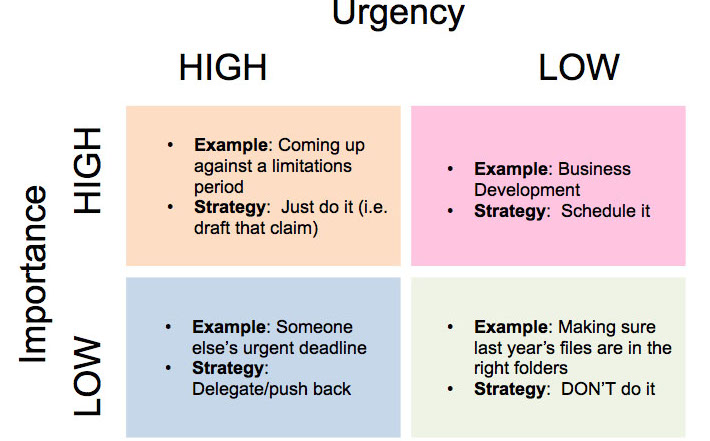In my last two columns, I offered up tips on how to bundle tasks and up your efficiency game — all to help you manage your time better. But no matter how much you bundle, or how efficient you are, you will never be able to do it all. In then end, some things just won’t get done, which means you have to prioritize — that is, decide what is truly important and what can be safely left at wayside.
And, all of my friends who went to business school have taught me there’s a tried-and-tested method to figure this out: the Eisenhower Matrix, invented by, you guessed it, former American president, Dwight Eisenhower. This is a standard concept at any MBA program and, in my opinion, it ought to find its way into the legal profession.
Here’s how it works: you build a chart (see below) that allows you to sort everything on your to-do list by urgency and importance.
Here’s how I might use the matrix on an average day:

As you can see, once I know what’s most important and most urgent, I know I have to do that first. If it’s urgent, but not all that important, I delegate the task; and if it’s important, but not that urgent, I’ll schedule it for later. If it’s neither important, nor urgent, I know I don’t have to do it.
Learning about this paradigm has shifted the way I think about my time and has forced me to focus on what is important.Time is, after all, our most precious resource. And this matrix helps me establish a plan. Give it a try and you should be prioritizing in no time — pun intended.
 Atrisha Lewis is a third-year associate in McCarthy Tétrault’s litigation group. Follow her on Twitter: @atrishalewis. And also check out all of her past columns.
Atrisha Lewis is a third-year associate in McCarthy Tétrault’s litigation group. Follow her on Twitter: @atrishalewis. And also check out all of her past columns.
Photo from Sean MacEntee


